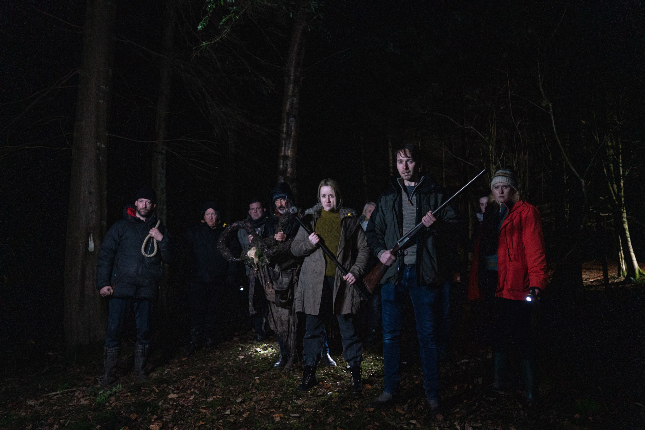Terror Takes Root in Irish Folk Horror Mandrake
Mandrake, Director Lynne Davison’s 85-minute feature film debut, opens with a scene at night in a foreboding, moss-covered forest (“the moss”). The camera looks down from above as a man who is chained around the neck digs desperately in the mud with his hands. He has found something that the audience cannot identify when a cacophonous screeching seems to deafen him, and he is then dragged off screen, deeper into the moss, by someone or something.
Davison, from the onset, uses the familiar don’t-show-the-monster technique. This works (as it often has) by establishing suspense and creating a pleasant sense of ambiguity. The viewer wants answers, and Davison and writer Matt Harvey buy themselves time to let the cinematography of Conor Rotherham (who worked on The Northman and Belfast) and the actors take over. Deirdre Mullins (BAFTA Best Actress winner for The Dark Mile) plays a tough parole officer Cathy Madden, and Derbhle Crotty (The Bright Side) plays “Bloody” Mary Laidlaw, who has just been released from prison.
After the bizarre but compelling opening scene in the moss, the scene cuts to an aerial view of a winter forest that eventually reveals a small town, bringing the focus on two men sitting outside of a gas station, drinking beer. The audience first meets Cathy, and a scuffle takes place with one of the men who she needs to bring to the station. Cathy is left with a bleeding hand. “It looks worse than it seems,” she says. The ironic statement sets the stage for the remainder of the film as the audience is brought to the Northern Island Probation Board where Cathy’s supervisor bandages her hand. “Bloody” Mary Laidlaw’s file is put on the table. One of Cathy’s coworkers doesn’t want the case, and so Cathy volunteers.
The backstory is established: Mary has just finished a life term. She had killed her husband with an axe after he beat her half to death and set her on fire. He had “left her for dead up there in the moss. It was a miracle she survived.” Words from the police report come into focus: “The Wanderer,” “ritualistic.” Slowly, some details are revealed, leaving more questions.
Davison has a knack for moving between jarringly close and ominously distant—from the flyover of the forest and the town to closeups on individual characters. The technique becomes a motif of sorts: the viewer is either too close to these characters or too far way in the most pleasurable of ways. It is character the drives the story forward, and we can’t quite be sure who these people are, or who may be involved in what’s brewing.
Before arriving at Mary’s house, Cathy drives aside a couple of kids, who she tells to leave. The children become a representation of what can happen when curiosity, innocence, and naiveté collide. When the viewer enters the house with Cathy, it’s clear that this is Mary’s domain—or a domain that has been vandalized by townspeople who think they know who Mary is. There is a ritualistic stick figure above the fireplace. Words and symbols are written on the wall, including “666” in pink handwriting. Which is Mary’s doing and which is vandalism is, of course, unclear.
When going to fit Mary with a monitoring ankle bracelet, Cathy rolls up Mary’s pantleg and discovers scarring. “You have cold hands,” Mary says. “I knew a man with hands nice and cold like that.”

Cathy seems on the brink of a panic attack when she leaves Cathy’s house. But curiosity about Cathy, and the stories she has heard about the incident with her husband, wins her battle with fear and so she researches Mary’s case. She stumbles upon words like “witchcraft” and “pagan practices” and “religious ceremony” and “rebirth.” Her son interrupts and scares Cathy.
Cathy’s fear becomes palpable, transferring to the audience. Mandrake fuses the suspense of the unknown with a general questioning of the nature of truth and reality. One of the many motifs is the use of fog, which seems to hang over every frame of the film. Even when a scene takes place indoors, the viewer gets a sense that if a door or window is opened, the fog will come right in. The fog is the presence of something that cannot be named or identified. It’s just there, even when it’s not.
Reminiscent of Guillermo Del Toro‘s Pan’s Labyrinth because of the use of the mandrake root and the dark uncertainty of the cinematography, the viewer arrives in this world and feels obligated to stay for the same reason that the characters do: we must know the truth, no matter how dangerous. Davison subtly integrates themes of identity: motherhood, femininity, innocence, and the role of the natural world. In the end, some of the initial questions are answered, but others are only amplified. Identity is elusive, and so it is at the end of Mandrake, even if we do better understand the motivations of these characters.
Mandrake is streaming on Shudder now
Featured Image Credit: Tom Cassese

